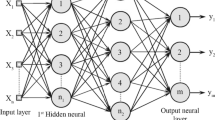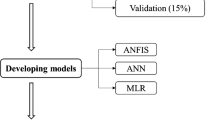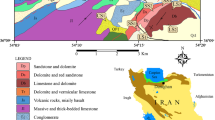Abstract
In this research, the north and northwest parts of Damghan in the northeast of Iran were selected as the study areas, and different sedimentary rocks including, sandstone, limestone, travertine, and conglomerate, were collected. Laboratory investigations including petrography study, X-ray diffraction, dry density, porosity, point load strength (PLS), Brazilian tensile strength (BTS), block punch strength (BPS), uniaxial compressive strength (UCS), and ultrasonic P-wave velocity (VP) were determined. The main aim of this study is to establish predictive models to estimate the PLS, BTS, BPS, and UCS of the studied rocks based on P-wave velocity. Four experimental models were developed using multivariate regression analysis (MRA), artificial neural network (ANN), and adaptive neuro-fuzzy inference system (ANFIS). Statistical parameters including, R, RMSE, VAF, MAPE, and PI, were calculated and compared to assess the performance of MRA, ANN, and ANFIS models. Correlation coefficient values were obtained from 0.73 to 0.85, 0.96 to 0.99, and 0.99 for the MRA, ANN, and ANFIS models, respectively. A good RMSE value equal to 0.11 was obtained for ANFIS when using VP for predicting block punch strength. Calculating residual error and correlation between experimental and predicted values indicated that the ANFIS models have the best coefficients. Also, the results of this research demonstrated that the ANN approach is more efficient than MRA in predicting the mechanical properties of the studied rocks.





















Similar content being viewed by others
References
Asheghi R, Shahri AA, Zak MK (2019) Prediction of uniaxial compressive strength of different quarried rocks using metaheuristic algorithm. Arab J Sci Eng 44:8645–8659
Abdelhedi M, Jabbar R, Mnif T, Abbes C (2020) Ultrasonic velocity as a tool for geotechnical parameters prediction within carbonate rocks aggregates. Arab J Geosci. https://doi.org/10.1007/s12517-020-5070-0
Aboutaleb S, Bagherpour R, Behnia M, Aghababaei M (2017) Combination of the physical and ultrasonic tests in estimating the uniaxial compressive strength and young’s modulus of intact limestone rocks. Geotech Geol Eng 35:3015–3023
Ajalloeian R, Jamshidi A, Khorasani R (2020) Assessments of ultrasonic pulse velocity and dynamic elastic constants of granitic rocks using petrographic characteristics. Geotech Geol Eng 38:2835–2844
Aldeeky H, Al Hattamleh O (2018) Prediction of engineering properties of basalt rock in Jordan using ultrasonic pulse velocity test. Geotech Geol Eng 36:3511–3525
Aliyu MM, Shang J, Murphy W, Lawrence JA, Collier R, Kong F, Zhao Z (2019) Assessing the uniaxial compressive strength of extremely hard cryptocrystalline flint. Int J Rock Mech Min Sci 113:310–321
Altindag R (2012) Correlation between P-wave velocity and some mechanical properties for sedimentary rocks. J Southern Afr Inst Min Metall 112(3):229–237
Amirkiyaei V, Ghasemi E, Faramarzi L (2020) Determination of P-wave velocity of carbonate building stones during freeze–thaw cycles. Geotech Geol Eng 38:5999–6009
ISRM (2007) The Blue Book: the complete ISRM suggested methods for rock characterization, testing and monitoring. In: Ulusay R, Hudson JA (eds) Compilation arranged by the ISRM Turkish National Group, Ankara, Turkey. Kazan Offset Press, Ankara, pp 1974–2006
Armaghani DJ, Amin MFM, Yagiz S, Faradonbeh RS, Abdullah RS (2016) Prediction of the uniaxial compressive strength of sandstone using various modeling techniques. Int J Rock Mech Min Sci 85:174–186
Armaghani DJ, Safari V, Fahimifar A, Amin MFM, Monjezi M, Mohammadi MA (2018) Uniaxial compressive strength prediction through a new technique based on gene expression programming. Neural Comput Applic 30:3523–3532
Arman H, Paramban S (2021) Dimensional effects on dynamic properties and the relationships between ultrasonic pulse velocity and physical properties of rock under various environmental conditions. Geotech Geol Eng 39:3947–3957
ASTM (1995) D2938: Standard test method for unconfined compressive strength of intact rock core specimens. ASTM International West Conshohocken
ASTM (1996) D2845-D2895: Standard test method for laboratory determination of pulse velocities and ultrasonic elastic constants of rock. ASTM International West Conshohocken
ASTM (2008) D5731-08: Standard test method for determination of the point load strength index of rock and application to rock strength classifications. ASTM International West Conshohocken
Azimian A, Ajalloeian R (2015) Empirical correlation of physical and mechanical properties of marly rocks with P wave velocity. Arab J Geosci 8:2069–2079
Basarir H, Dincer T (2019) Prediction of rock mass P wave velocity using blast hole drilling information. Int J Min Rec Environ 33(1):61–74
Bell FG (2000) Engineering properties of soils and rocks, 4th edn. Blackwell Science, Oxford
Benavente D, Galiana-Merino JJ, Pla C, Martinez-Martinez J, Crespo-Jimenez D (2020) Automatic detection and characterisation of the first P and S-wave pulse in rocks using ultrasonic transmission method. Eng Geol. https://doi.org/10.1016/j.enggeo.2020.105474
Broch E, Franklin JA (1972) The point load strength test. Int J Rock Mech Min Sci 9:669–697
Ceryan N, Okkan U, Kesimal A (2013) Prediction of unconfined compressive strength of carbonate rocks using artificial neural networks. Environ Earth Sci 68:807–819
Chawre B (2018) Correlations between ultrasonic pulse wave velocities and rock properties of quartz-mica schist. J Rock Mech Geotech Eng 10:594–602
Cobanoğlu I, Çelik S (2008) Estimation of uniaxial compressive strength from point load strength, Schmidt hardness and P-wave velocity. Bull Eng Geol Environ 67:491–498
Diamantis K (2019) Estimation of tensile strength of ultramafic rocks using indirect approaches. Geomech Eng 17(3):261–270
Diamantis K, Bellas S, Migiros G, Gartzos E (2011) Correlating wave velocities with physical, mechanical properties and petrographic characteristics of peridotites from the Central Greece. Geotech Geol Eng 29(6):1049–1062
Diamantis A, Karamousalis T, Gartzos E, Migiros G (2012) Pulse transmission techniques for the characterization of serpentinites from central Greece. Q J Eng Geol Hydro 45(3):369–678
Diamantis K, Fereidooni D, Khajevand R, Migiros G (2021) Effect of textural characteristics on engineering properties of some sedimentary rocks. J Cent South Univ 28:926–938
Ding C, Hu D, Zhou H, Lu J, Lv T (2020) Investigations of P-Wave velocity, mechanical behavior and thermal properties of anisotropic slate. Int J Rock Mech Min Sci. https://doi.org/10.1016/j.ijrmms.2019.104176
Ersoy H, Karahan M, Babacan AE, Sünnetci MO (2019) A new approach to the effect of sample dimensions and measurement techniques on ultrasonic wave velocity. Eng Geol 251:63–70
Fener M (2011) The effect of rock sample dimension on the P-wave velocity. J Nondestruct Eval 30:99–105
Ferentinou M, Fakir M (2017) An ANN approach for the prediction of uniaxial compressive strength, of some sedimentary and igneous rocks in Eastern KwaZulu-Natal. Procedia Eng 191:1117–1125
Ghafoori M, Rastegarnia A, Lashkaripour GR (2018) Estimation of static parameters based on dynamical and physical properties in limestone rocks. J Afr Earth Sci 137:22–31
GSI (Geological Society of Iran) (1977) Geological quadrangle map of Iran, No. 6862, Scale 1:100000, Printed by Offset Press Inc. Tehran
Hassan A, Sanuade OA, Olaseeni OG (2021) Prediction of physico-mechanical properties of intact rocks using artificial neural network. Acta Geophys 69:1769–1788
Heidari M, Mohseni H, Jalali SH (2018) Prediction of uniaxial compressive strength of some sedimentary rocks by fuzzy and regression models. Geotech Geol Eng 36:401–412
Heidari M, Ajalloeian R, Ghazifard A, Isfahanian MH (2020) Evaluation of P and S wave velocities and their return energy of rock specimen at various lateral and axial stresses. Geotech Geol Eng 38:3253–3270
Hemeda S, Pitilakis K (2010) Serapeum temple and the ancient annex daughter library in Alexandria, Egypt: geotechnical–geophysical investigations and stability analysis under static and seismic conditions. Eng Geol 113:33–43
IAEG (1979) Classification of rocks and soils for engineering geological map**, part 1: rock and soil materials. Rep Comm Eng Geol Mapp Bull Int Assoc Eng Geol 19:364–371
ISRM (1981) Suggested methods for determining hardness and abrasiveness of rocks, Part 3. Commission on standardization of laboratory and field tests 101–112
ISRM (1985) Suggested method for determining point load strength: ISRM Comm. on testing methods. Int J Rock Mech Min Sci Geomech Abstr. 22(4):112
Jamshidi A, Zamanian H, Sahamieh RZ (2018) The effect of density and porosity on the correlation between uniaxial compressive strength and P-wave velocity. Rock Mech Rock Eng 51:1279–1286
Jang JSR (1993) ANFIS: adaptive network-based fuzzy inference systems. IEEE Trans Sys Man Cybern 23(3):665–685
**g H, Nikafshan Rad H, Hasanipanah M, Armaghani DJ, Noman Qasem S (2021) Design and implementation of a new tuned hybrid intelligent model to predict the uniaxial compressive strength of the rock using SFS-ANFIS. Eng Comput 37:2717–2734
Johari A, Fazeli A, Javadi AA (2013) An investigation into application of jointly distributed random variables method in reliability assessment of rock slope stability. Comput Geotech 47:42–47
Johari A, Momeni M, Javadi AA (2015) An analytical solution for reliability assessment of pseudo-static stability of rock slopes using jointly distributed random variables method. Iran J Sci Technol Trans Civil Eng 39(C2):351–363
Kahraman S (2001) Evaluation of simple methods for assessing the uniaxial compressive strength of rock. Int J Rock Mech Min Sci 38:981–994
Khajevand R, Fereidooni D (2018) Assessing the empirical correlations between engineering properties and P wave velocity of some sedimentary rock samples from Damghan, northern Iran. Arab J Geosci. https://doi.org/10.1007/s12517-018-3810-1
Khajevand R, Fereidooni D (2019) Utilization of the point load and block punch strengths to predict the mechanical properties of several rock samples using regression analysis methods. Innov Infrastruct Solut. https://doi.org/10.1007/s41062-019-0201-8
Khajevand R, Fereidooni D (2022) The effects of water acidity and engineering properties on rock durability. Earth Sci Res J 6(1):67–79
Khandelwal M, Singh TN (2009) Correlating static properties of coal measures rocks with p-wave velocity. Int J Coal Geol 79:55–60
Khandelwal M, Armaghani DJ, Faradonbeh RS, Yellishetty M, Majid MZA, Monjezi M (2017) Classification and regression tree technique in estimating peak particle velocity caused by blasting. Eng Comput 33(1):45–53
Kianpour M, Fatemi Aghda SM, Talkhablou M (2019) Classification of limestone rock masses using laboratory and field P-wave velocity by ArcGIS fuzzy overlay (AFO) (case study: five dam sites in Zagros Mountains, western Iran). Geotech Geol Eng 38:631–650
Kilic A, Teymen A (2008) Determination of mechanical properties of rocks using simple methods. Bull Eng Geol Environ 67:237–244
Kurtulus C, Sertcelik F, Sertcelik I (2016) Correlating physico-mechanical properties of intact rocks with P-wave velocity. Acta Geod Geophys 51:571–582
Mahdiabadi N, Khanlari G (2019) Prediction of uniaxial compressive strength and modulus of elasticity in calcareous mudstones using neural networks, fuzzy systems, and regression analysis. Period Polytech Civil Eng 63(1):104–114
MATLAB and Statistical Toolbox Released 2020b the mathworks (2020), Inc., Natick, Massachusetts, United States
Mohammed DA, Alshkane YM, Abdalqadir ZK (2019) Evaluation of empirical equations to estimate the mechanical properties of sedimentary rocks using ultrasonic pulse velocity (UPV). Eur J Sci Eng 4(4):135–147
Momeni E, Armaghani DJ, Hajihassani M, Amin MFM (2015) Prediction of uniaxial compressive strength of rock samples using hybrid particle swarm optimization-based artificial neural networks. Measurement 60:50–63
Moussas VC, Diamantis K (2021) Predicting uniaxial compressive strength of serpentinites through physical, dynamic and mechanical properties using neural networks. J Rock Mech Geotech Eng 13:167–175
Mozumder RA, Laskar AI (2015) Prediction of unconfined compressive strength of geopolymer stabilized clayey soil using Artificial Neural Network. Comput Geotech 69:291–300
Paul S, Ali M, Chartterjee R (2018) Prediction of compressional wave velocity using regression and neural network modeling and estimation of stress orientation in Bokaro Coalfield, India. Pure Appl Geophys 175:375–388
Saedi B, Mohammadi SD, Shahbazi H (2019) Application of fuzzy inference system to predict uniaxial compressive strength and elastic modulus of migmatites. Environ Earth Sci. https://doi.org/10.1007/s12665-019-8219-y
Salehin S, Hadavandi E, Chelgani SC (2020) Exploring relationships between mechanical properties of marl core samples by a coupling of mutual information and predictive ensemble model. Model Earth Sys Environ 6:575–583
Sarkar K, Tiwary A, Singh TN (2010) Estimation of strength parameters of rock using artificial neural networks. Bull Eng Geol Environ 69:599–606
Sharma LK, Singh TN (2018) Regression-based models for the prediction of unconfined compressive strength of artificially structured soil. Eng Comput 34:175–186
Sharma LK, Vishal V, Singh TN (2017) Develo** novel models using neural networks and fuzzy systems for the prediction of strength of rocks from key geomechanical properties. Measurement 102:158–169
Shen X, Chen M, Lu W, Li L (2017) Using P wave modulus to estimate the mechanical parameters of rock mass. Bull Eng Geol Environ 76:1461–1470
Shirole D, Hedayat A, Ghazanfari E, Walton G (2020) Evaluation of an ultrasonic method for damage characterization of brittle rocks. Rock Mech Rock Eng 53:2077–2094
Singh R, Vishal V, Singh TN, Ranjith PG (2013) A comparative study of generalized regression neural network approach and adaptive neuro-fuzzy inference systems for prediction of unconfined compressive strength of rocks. Neural Comput Applic 23:499–506
Singh PK, Tripathy A, Kainthola A, Mahanta B, Singh V, Singh TN (2017) Indirect estimation of compressive and shear strength from simple index tests. Eng Comput 33:1–11
Takagi T, Sugeno M (1985) Fuzzy identification of systems and its applications to modeling and control. IEEE Trans Syst Man Cybern 15(1):116–132
Tandon RS, Gupta V (2015) Estimation of strength characteristics of different Himalayan rocks from Schmidt hammer rebound, point load index, and compressional wave velocity. Bull Eng Geol Environ 74:521–533
Teymen A, Mengüç EC (2020) Comparative evaluation of different statistical tools for the prediction of uniaxial compressive strength of rocks. Int J Min Sci Tech 30:785–797
Tuğrul A, Zarif IH (1999) Correlation of mineralogical and textural, characteristics with engineering properties of selected granitic rocks from Turkey. Eng Geol 51(4):303–317
Ulusay R, Gokceoglu C, Sulukcu S (2001) Draft ISRM suggested method for determining block punch strength index (BPI). Int J Rock Mech Min Sci 38(8):1113–1119
Vasanelli E, Micelli F, Colangiuli D, Calia A, Aiello MA (2020) A non-destructive testing method for masonry by using UPV and cross validation procedure. Mat Struct 53:134–149
Wang Y, Han JQ (2020) Geomechanical and ultrasonic characteristics of black shale during triaxial deformation revealed using real-time ultrasonic detection dependence upon bedding orientation and confining pressure. Geotech Geol Eng 38:6773–6794
Wang T, Zhang H, Gamage RP, Zhao W, Ge J, Li Y (2020) The evaluation criteria for rock brittleness based on double-body analysis under uniaxial compression. Geomech Geophys Geo-Energ Geo-Resour 6:49. https://doi.org/10.1007/s40948-020-00165-x
Yagiz S (2011) P-wave velocity test for assessment of geotechnical properties of some rock materials. Bull Mater Sci 34(4):947–953
Yang F, Hu D, Zhou H, Lu J (2020) Physico-mechanical behaviors of granite under coupled static and dynamic cyclic loadings. Rock Mech Rock Eng 53:2157–2173
Yasar E, Erdogan Y (2004) Correlating sound velocity with the density, compressive strength and Young’s modulus of carbonate rocks. Int J Rock Mech Min Sci 41:871–875
Zadeh LA (1965) Fuzzy sets. Info Control 8:338–353
Acknowledgements
The author like to express his thanks to Mr. P. Khajevand for the English editing.
Funding
No external funding was used.
Author information
Authors and Affiliations
Corresponding author
Ethics declarations
Conflict of interest
The author does not have any conflict of interest.
Ethical Approval
This article does not contain any studies with human participants.
Rights and permissions
Springer Nature or its licensor (e.g. a society or other partner) holds exclusive rights to this article under a publishing agreement with the author(s) or other rightsholder(s); author self-archiving of the accepted manuscript version of this article is solely governed by the terms of such publishing agreement and applicable law.
About this article
Cite this article
Khajevand, R. Estimating Geotechnical Properties of Sedimentary Rocks Based on Physical Parameters and Ultrasonic P-Wave Velocity Using Statistical Methods and Soft Computing Approaches. Iran J Sci Technol Trans Civ Eng 47, 3785–3809 (2023). https://doi.org/10.1007/s40996-023-01148-0
Received:
Accepted:
Published:
Issue Date:
DOI: https://doi.org/10.1007/s40996-023-01148-0




